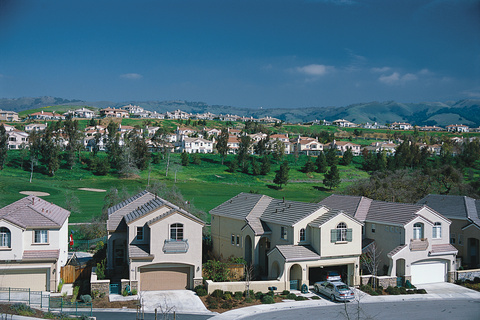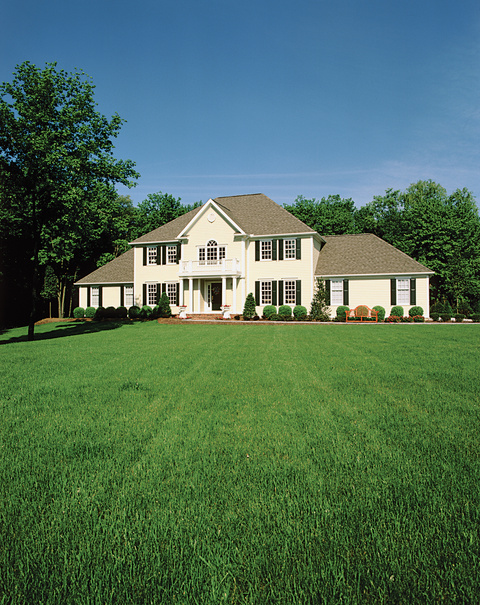An Introduction to Landscape Design
Missing the Mark
Landscape design is a matter of personal taste, but there are some approaches that almost any designer would recommend against.

Home developments built around golf courses are often designed as insular sites that disregard the opportunities for social interaction presented by community oriented landscape architecture.
Most of the bad ideas in landscape architecture and gardens come from a lack of sensitivity to existing conditions, which can result in features that damage the land and ultimately become eyesores for their disharmony with their setting.
Dry Idea
Many homes in arid climates still
maintain full, lush lawns that soak up dwindling water supplies and cost
a fortune to maintain. Though planting cacti and opting for gravel instead of rock does require less water, it does not necessarily make for an exciting landscape design. A haphazard succulent planting is as visually uninteresting as a giant green lawn.
Water, Water Everywhere
“Pools mar all, and make the garden unwholesome and full of flies and frogs,” claimed 17th-century landscape designer Francis Bacon, and, indeed, a poorly designed water feature does this and more. For a water feature or pool to be successful, it must be well integrated in the site. A high-graded, babbling brook that originates from a stone fence, for example, is not a good approach. Sure it’s great to have an oasis, but if beyond the fence one can see only a flat, dry landscape, the feature loses its relevance. Furthermore, it’s incredibly resource-inefficient.
Cutting the Edge
When designing an edge in a landscape composition, it’s important to
ask, “Why am I creating an edge here?” If you can’t answer that question, or if
your answer involves a wonky U-shape enclosing mulch or arbitrary low-lying ground cover, then it might be smart to rethink your concept. As a wise
designer might recommend, “When
in doubt—–don’t.” Evergreen hedges can be an interesting design tool,
as evinced by the Klahn + Singer +
Partner project in "Well Pruned;" however,
a cabinet is meant to enclose a walk-
way and create a visual separation within the composition. Tonsure should
be administered with discretion—–
pruning evergreens into the shape of mythical creatures or gigantic conical shapes is not advised, especially if
it obscures one of the few windows in your home and darkens living spaces.
Off Course

Homes that maintain full, lush lawns in unsuitable climates not only become disharmonious eyesores, they also soak up dwindling water supplies.
Alan Berger, who teaches urban design and landscape architecture at MIT, refers to poorly planned housing developments as “waste landscapes of dwelling” and cites residential golf communities as being some of the more egregious examples of this. These communities are often built around an insular site plan with little regard for pedestrian integration or environmentally appropriate planting (a golf course, obviously, is not a fine example of responsible landscape design—–especially in a city like Scottsdale, Arizona). Recreation is designated to one particular zone (the gym facility, the golf course), creating a dislocated circulation pattern and limiting opportunity for social interaction.
An Introduction to Landscape Design
The profession of landscape architecture is very much rooted in the European tradition of garden design, and it didn’t germinate as a distinct profession in the United States until the 19th century.

Illustrations of a California-style residential landscape design (left), and a 13th century Mudéjar-style estate garden (right).
In conjunction with the field of urban planning, designers like Frederick Law Olmsted set out to shape the municipal American landscape alongside garden designers such as Beatrix Jones Farrand (the niece of the great American novelist Edith Wharton) and Warren H. Manning. These designers, among others, had a hand in designing many of the great estate gardens throughout the country. Farrand was the only woman among the 11 founding members of the American Society of Landscape Architects (ASLA). In 1899, the group set out to “establish landscape architecture as a recognized profession in North America, develop educational studies in landscape architecture, [and] provide a voice of authority in the ‘New Profession.’”
As the landscape architect Thomas Dolliver Church explains in his book Gardens Are for People: “The Columbian Exposition in 1893 ushered in the greatest wave of ‘copyism’ since England discovered Palladio.…While this resulted in some fine reproductions of old-world gardens, it proved the hollowness of imitation without reason.” Church, who created some of the most iconic California-style domestic landscapes of the 20th century, stated that what was needed was for “modern” to be “revived as an honest word”—–that designers must “realize that modernism is not a goal but a broad highway.” This, of course, is true for any medium, but perhaps particularly so for one that deals so directly with our surrounding environment and our public spaces.
Today’s landscape architect or designer must work within a number of social and climatic parameters. The disappearance of natural and rural space—–not to mention environmental imperatives stemming from climate change—–are shaping the field dramatically and encouraging practi- tioners to do more than simply create aesthetically pleasing landscapes. Most contemporary practices do a combination of public and private design as well as large-scale restoration and redevelopment projects. No matter the scale, the process always involves organizing and shaping a landscape for a desired effect and function. Incorporating elements of spatial division through fencing, planar manipulation, built-in seating, water features, and hardscaping allows land- scape architects and designers to create more fluid spaces. Today, most trained practitioners are well versed in sustainable applications and are able to create environmentally sensitive landscapes through xeriscaping (drought-tolerant planting), native planting, smart irrigation, and the incorporation of green roofs.
Though domestic landscapes may not possess the grandeur of some large-scale corporate and municipal commissions, they serve as a succinct encapsulation of how a landscape architect works. A successfully designed landscape will not only be more useful, it will also be more beautiful.